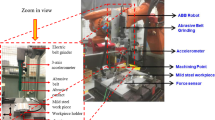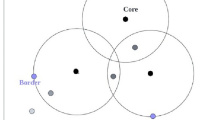Abstract
This study develops a micro-tool condition monitoring system consisting of accelerometers on the spindle, a data acquisition and signal transformation module, and a backpropagation neural network. This study also discusses the effect of the sensor installations, selected features, and the bandwidth size of the features on the classification rate. To collect the vibration signals necessary for training the system model and verifying the system, an experiment was implemented on a micro-milling research platform along with a 700 μm diameter micro-end mill and a SK2 workpiece. A three-axis accelerometer was installed on a sensor plate attached to the spindle housing to collect vibration signals in three directions during cutting. The frequency domain features representing changes in tool wear were selected based on the class mean scatter criteria after transforming signals from the time domain to the frequency domain by fast Fourier transform. Using the appropriate vibration features, this study develops and tests a backpropagation neural network classifier. Results show that proper feature extraction for classification provides a better solution than applying all spectral features into the classifier. Selecting five features for classification provides a better classification rate than the case with four and three features along with the 30 Hz bandwidth size of the spectral feature. Moreover, combining the signals for tool condition from both direction signals provides a better classification rate than determining the tool condition using a one-direction single sensor.
Similar content being viewed by others
References
Masuzawa T (2000) State of the art of micromachining. CIRP Ann 49(2):473–488
Ehmann K, DeVor R, Kapoor S (2002) Micro/meso-scale mechanical manufacturing—opportunities and challenges. Proceedings, JSME/ASME International Conference on Materials and Processing, October 15–18, Honolulu, HI 1:6–13 (Keynote presentation).
Chae J, Park S, Freiheit T (2006) Investigation of micro-cutting operations. Int J Mach Tools Manuf 46:313–332
Dornfeld D, Min S, Takeuchi Y (2006) Recent advances in mechanical micromachining. Annals of the CIRP 55(2):745–768
Byrne G, Dornfeld D, Inasaki I, Ketteler G, Konig W, Teti R (1995) Tool condition monitoring (TCM)—the status of research and industrial application. Annals of CIRP 44(2):541–567
Dimla E, Dimla Snr DE (2000) Sensor signals for tool-wear monitoring in metal cutting operations—a review of methods. Int J Mach Tools Manuf 40:1073–1098
Jemielniak K (1999) Commercial tool condition monitoring systems. Int J Adv Manuf Technol 15:711–721
Rehorn AG, Jiang J, Orban PE (2005) State-of-the-art methods and results in tool condition monitoring: a review. Int J Adv Manuf Technol 26:693–710
Abellan-Nebot JV, Subirón FR (2010) A review of machining monitoring systems based on artificial intelligence process models. Int J Adv Manuf Technol 47:237–257
Abu-Mahfouz I (2003) Drilling wear detection and classification using vibration signals and artificial neural network. Int J Mach Tools Manuf 43:707–720
EL-Wardany TI, Gao D, Elbestawi MA (1995) Tool condition monitoring in drilling using vibration signature analysis. Int J Mach Tools Manuf 36(6):687–711
Alonso FJ, Salgado DR (2008) Analysis of the structure of vibration signals for tool wear detection. Mech Syst Signal Process 22:735–748
Yee KW, Blomquist DS (1984) Rotating tool wear monitoring apparatus. USP. 04471444
Issam AM (2003) Drilling wear detection and classification using vibration signals and artificial neural network. Int J Mach Tools Manuf 43:707–720
Barker RW, Klutke G, Hinich MJ (1993) Monitoring rotating tool wear using higher-order spectral features. J Eng Ind 115(1):23–29
Forsgren R, Garpendahl G, Eriksson H, Wallentin B (1985) Method and apparatus for monitoring the tool status in a tool machine with cyclic machining. USP. 04558311
Miyoshi Y (1993) Abnormal cutting state detection using model parameters. J Japan Soc Precis Eng 59(3):467–473
Zhang J, Chen JC (2008) Tool condition monitoring in an end-milling operation based on the vibration signal collected through a microcontroller-based data acquisition system. Int J Adv Manuf Technol 39:118–128
Yan J, Lee J (2007) A hybrid method for on-line performance assessment and life prediction in drilling operations. Proceedings of the IEEE International Conference on Automation and Logistics, Jinan, China
Kandilli I, Sonmez M, Ertunc HM, Cakir B, and Huseyin (2007) Online monitoring of tool wear in drilling and milling by multi-sensor neural network fusion. Proceedings of the IEEE International Conference on Mechatronics and Automation 1388–1394
Kim JD, Choi IH (1996) Development of a tool failure detection system using multi-sensors. INT J MachTools Manufact 36:861–870
Binsaeid S, Asfour S, Cho S, Onar A (2009) Machine ensemble approach for simultaneous detection of transient and gradual abnormalities in end milling using multisensor fusion. J Mater Process Technol 209:4728–4738
Deiab I, Assaleh K, Hammad F (2009) On modeling of tool wear using sensor fusion and polynomial classifiers. Mech Syst Signal Process 23:1719–1729
Aliustaoglu C, Ertunc MH, Ocak H (2009) Tool wear condition monitoring using a sensor fusion model based on fuzzy inference system. Mech SystSignal Process 23:539–546
Ghosh N, Ravi YB, Mukhopadhyay S, Paul K, Mohanty AR, Chattopadhyay AB (2007) Estimation of tool wear during CNC milling using neural network-based sensor fusion. Mech Syst Signal Process 21:446–479
Cho S, Binsaeid S, Asfour S (2010) Design of multi-sensor fusion-based tool condition monitoring system in end milling. Int J Adv Manuf Technol 46:681–694
Malekiana M, Parka SS, Martin BG (2009) Tool wear monitoring of micro-milling operations. J Mater Process Technol 209:4903–4914
Tansel I, Rodriguez O, Trujillo M, Paz E, Li W (1998) Micro-end-milling—I. wear and breakage. Int J Mach Tools Manuf 38:1419–1436
Tansel I, Arkan T, Bao WY, Mahendrakar N, Shisler B, Smith D, McCool M (2000) Tool wear estimation in micro-machining part II: neural-network-based periodic inspector for non-metals. Int J Mach Tools Manuf 40:609–620
Tansel I, Trujillo M, Nedbouyan A, Velez C, Bao WY, Arkan TT (1998) Micro-end-milling––III. Wear estimation and tool breakage detection using acoustic emission signals. Int J Mach Tools Manuf 38:609–620
Jemielniak K, Arrazola PJ (2008) Application of AE and cutting force signals in tool condition monitoring in micro-milling. CIRP J Manuf Sci Technol 1:97–102
Zhu K, Wong YS, Hong GS (2009) Multi-category micro-milling tool wear monitoring with continuous hidden Markov models. Mech Syst Signal Process 23:547–560
Emel E, Kannatey-Asibu E Jr (1988) Tool failure monitoring in turning by pattern recognition analysis of AE Signals. ASME J Eng Ind 110:137–145
Bishop CM (2007) Neural networks for pattern recognition. Oxford University Press, Oxford
Acknowledgment
This research was supported in part by the Taiwan Department of Economics under Grant 97-EC-17-A-05-S1-101.
Author information
Authors and Affiliations
Corresponding author
Rights and permissions
About this article
Cite this article
Hsieh, WH., Lu, MC. & Chiou, SJ. Application of backpropagation neural network for spindle vibration-based tool wear monitoring in micro-milling. Int J Adv Manuf Technol 61, 53–61 (2012). https://doi.org/10.1007/s00170-011-3703-x
Received:
Accepted:
Published:
Issue Date:
DOI: https://doi.org/10.1007/s00170-011-3703-x




